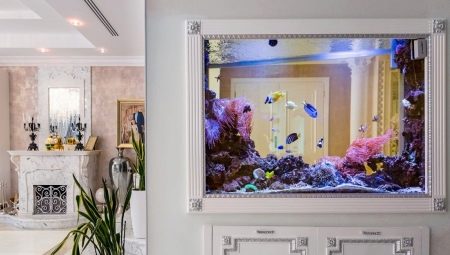The aquarium can rightfully be considered one of the typical attributes of a modern apartment. Although the word “typical” is not entirely correct, because a water reservoir can be so different from its more conservative-looking counterparts that you cannot put it in the general row.
Huge and expensive or small, but stylish, they become an integral element of the living room (or kitchen combined with the living room). One of the most popular options for today is the aquarium located in the wall.

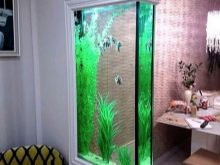
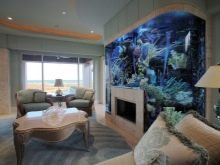
Basic location requirements
Built-in aquariums are designs with specific features. To install an aquarium in the wall, you will have to take into account a number of points.
- A tank like this needs a very solid base. Only this can handle the load.
- Before installing lighting equipment, simple calculations are required. Aquariums are placed away from the window, because they are deprived of natural light. But without light, representatives of the flora and fauna in a domestic pond will not survive.
- Do not place the built-in aquarium next to heating appliances, with temperature fluctuations, many species of fish can die.
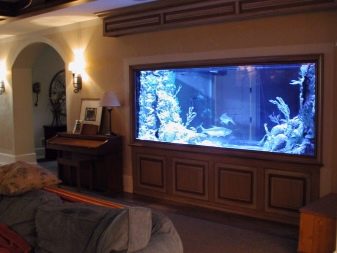

Usually, work on creating an integrated aquarium begins with a plan. You yourself can schematically draw your interior and designate where in it there is a place for an aquarium. Then analyze what can be done independently of what you have planned, and what requires skilled hands of specialists. It is easier to install a square or rectangular tank in the wall.
The lateral parts of the aquarium can either go beyond the plane of the wall or merge with it.
The aquarium is usually built in so that it is visible from anywhere in the room. The wall under it should be free, without being overloaded with details. Tanks in the center of the wall look most advantageous, like paintings.
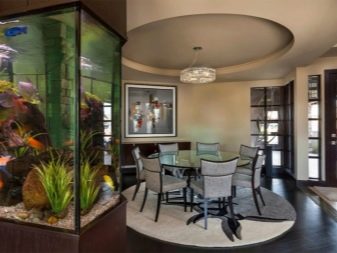
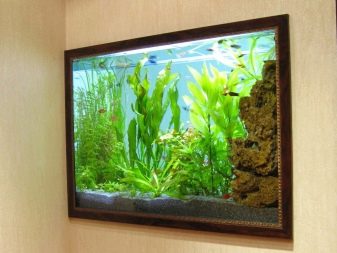
If the apartment is designed as a studio, then the aquarium can be placed in a partition that does not have a door that performs the function of a zoner. This decorates her cool and turns the apartment from a modest studio into a very stylish space.
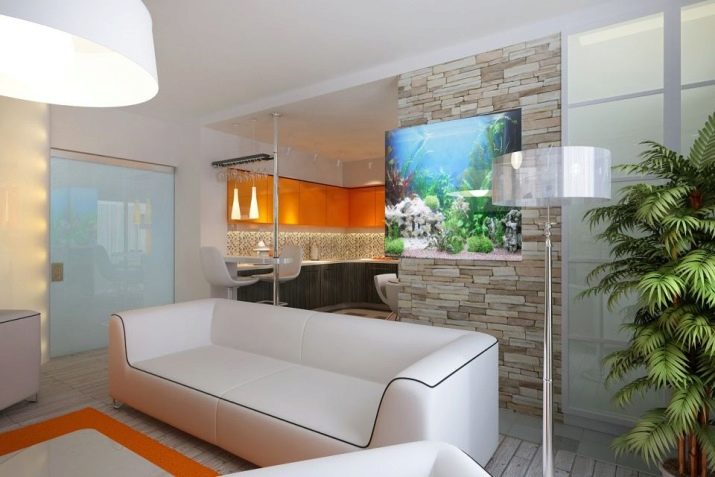
Advantages and disadvantages
Such an idea will have more advantages than disadvantages. Mankind has known aquariums for more than a thousand years. In addition to the fact that it is simply beautiful, aquarium helps a person psychologically discharge, to escape from multitasking and fuss. The underwater landscape, elegant fish and beautiful plants make you look at them for a long time and enjoy it.

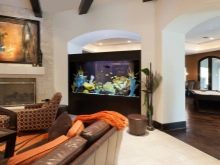

People admit that the aquarium in the house is their personal comfort zone, which helps to come to harmony, balance, calm down.
Of the other positive properties of an aquarium built into the wall, such are noted.
- It helps to visually increase the space. The play of water and light creates the desired effect for small rooms. If the room is on the sunny side, the effect will intensify.
- Disguises room defects. And this is also proved - if a beautiful aquarium is built into the wall, for some irregularities and other errors in the decoration, the look no longer “clings”.
- Relieves stress. And we can talk about this again, because in addition to the psychological mood, contemplation of the home underwater kingdom even allows you to normalize blood pressure indicators. The aquarium cannot be called a hypotensive agent in all seriousness, but the fact that it really often becomes an acquisition of hypertension is a fact. This is a good home relaxant.
- Serves as a home living corner. If children grow up in the house, the aquarium for them is a living natural alphabet. Attentive parents will teach kids to take care of the "house for the fish", form concepts about care and respect for all living things.
- Significantly transforms the interior. If there is no money for a full repair, you will have to spend it on one thing, which can significantly change the image of the room. And the aquarium in the wall does a great job of doing this - it looks good in rooms that are not “crushed” by decor, helps uninhabited spaces look more alive, and attracts attention.
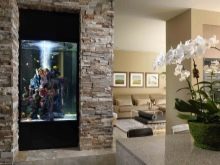
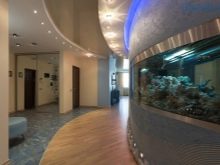

It remains, in contrast to this list, to cite the shortcomings. One of them - the inability in 100% of cases to build an aquarium in the wall. Not all walls can withstand this design, and in most cases you have to turn to specialists. Small efforts to make such a design trick will not work.
Finally (unless you install a dry aquarium) The built-in design will have to be constantly monitored. Fish require food and regular water changes, plants may need to be fed. You will have to look at how the filter works, you need to siphon the soil, etc.
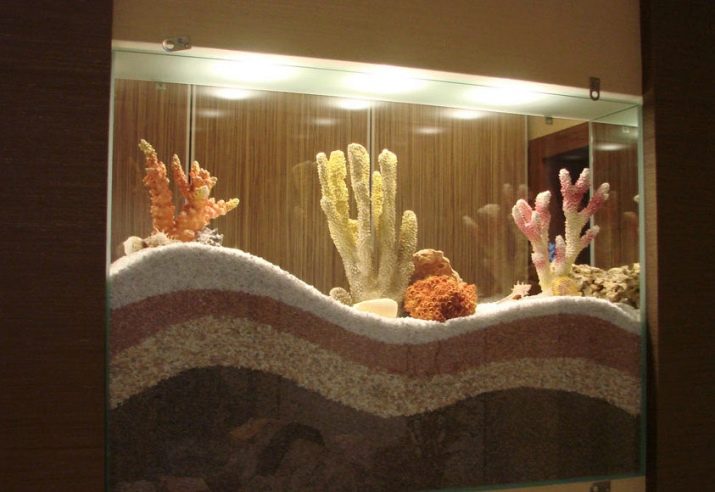
In a word, aquarium research is not only a hobby, but also a job.
Species overview
There are several models of wall-mounted aquariums, consider the most common of them.
The first option is built-in niche designs. Bearing structures cannot be used in such an installation, because such tanks cannot become an adornment of apartments in panel houses. When vegetation and fish are selected in such a container, its oblong shape is taken into account.
For decor, artificial flora is usually used, which is clearly visible in the niche. Similar designs come with a decorative background, and this, of course, does not simplify maintenance.
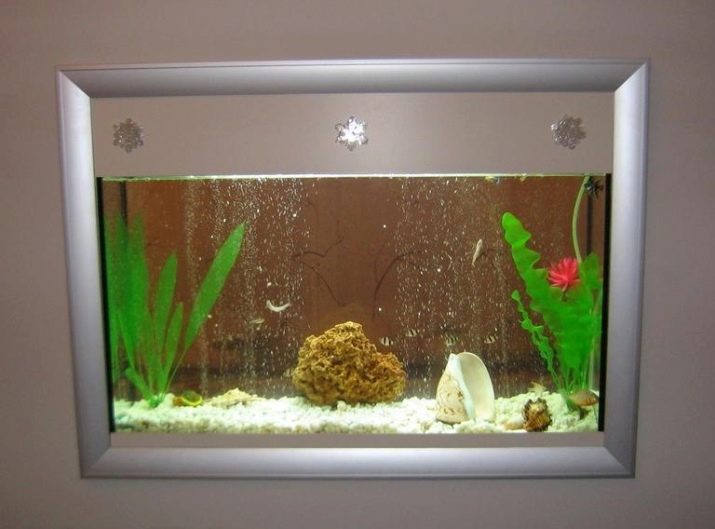
To reduce costs, aquarists prefer tanks with a volume of 100-120 liters.
The next option is built-in designs. The small underwater world in the wall between the rooms today is considered a very popular option, because it can be viewed from 3-4 sides, and the interior only benefits from such an element.
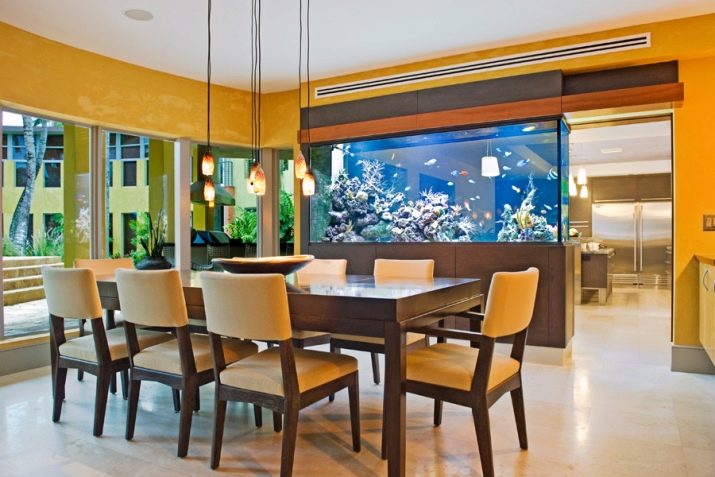
But there are certain nuances in the case of an aquarium built into a partition:
- Specialists will bring filtration equipment to the tank, which works all the time;
- in the aquarium you need to replace water, clean it with ultraviolet light, otherwise you can’t avoid the accumulation of organic, toxic and dangerous;
- to fill such an aquarium requires the use of phenotypes that can withstand stress, because in these containers it is not easy to hide;
- the service of such a tank will take a lot of time and effort.
Another interesting option is installation of the tank in a decorative partition, which can be located in any part of the house. It also serves as a decorative space zoner. To conveniently maintain the structure, a place is left on top that allows you to easily install lighting equipment, filters and other devices to maintain life in the aquarium.
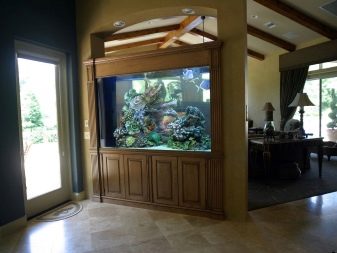
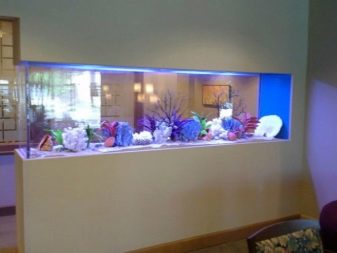
And there are still thin aquariums in furniture, in the floor, in a large closet. A good alternative (and much more affordable) to all of these options can be considered a large flat artificial aquarium on the wall.
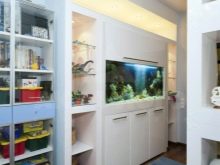
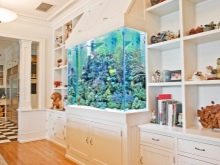

This is nothing more than an imitation, a “trick”, but it can also be stylish, elegant, impressive.
An artificial hanging aquarium can be compared to an artificial fireplace. Yes, this is only a game in the underwater world, but she also has her own beneficial sides.
- First, technology has gone very far, and few at first glance will determine if this is an aquarium or an imitation.
- Secondly, there are many people who believe that home aquariums are disrespect for the animal kingdom. and do not dare to get home such "houses for fish" for fun. But the artificial version of ethical claims does not arise.
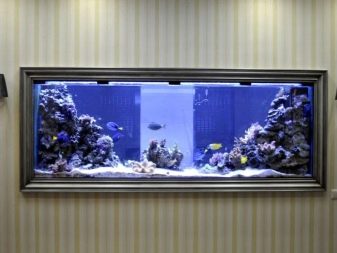

You should not immediately acquire a large and complex aquarium, plant rare inhabitants and strange plants there, if you have no experience in caring for the simplest tank with guppies or cockerels.
Aquarium science makes sense to learn on the principle of "from simple to complex."
Design Features
The first and most important rule is to carefully consider how the aquarium will look, what its design and content will look like. It's a shame if during the installation of such a design it is not possible to create harmony in space. But the color scheme decides a lot in the interior of the room, and if the aquarium is made in the same colors that do not overlap with the decoration of the walls and other surfaces, the unity of style and organic picture will not happen.

The styles of aquariums are clearly marked and can become a guideline for the design of your tank. In this case, you need to adhere to the designated design and not go beyond its framework.
- Japanese. Imitation of nature is not the main idea of this aqua-design, in the center of the Japanese style is a composition that should have a calming effect on the contemplator. Borrowing from a rock garden, bonsai technique, Japanese culture as a whole are guessed. But the basic rule for this design of aquariums is minimalism.
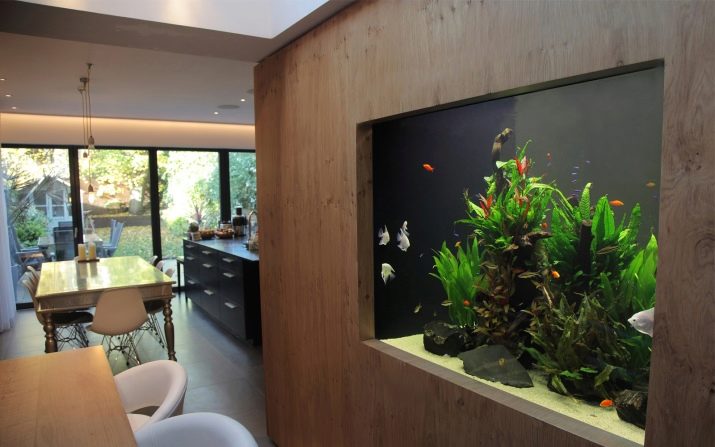
- Dutch. And this is a real underwater garden, requiring careful filling, resembling a flower bed with plants sorted by characteristics. Plants are arranged in tiers, this is the highlight of the Dutch style.
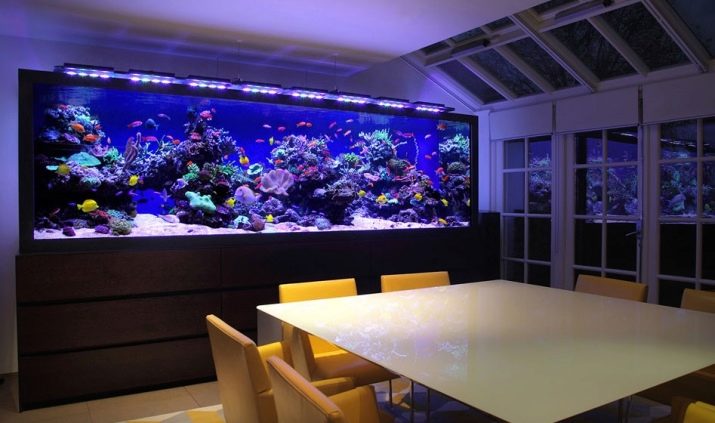
- Nautical. The most popular style. The aquarium is filled with sea water and inhabited by authentic inhabitants (and this is not only fish). If you follow the rules of contrast in the selection of fish, use the most spectacular plants, you will not have to doubt the spectacle of the overall composition. The small sea right at home is a good help to those who yearn for a vacation on the seashore.
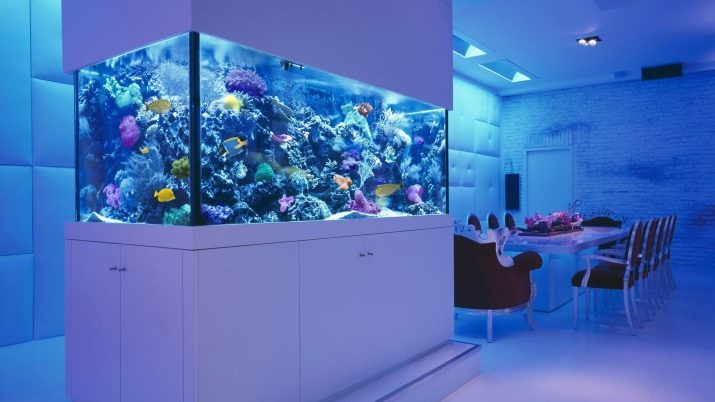
- Natural (biotope) style. This option involves an extremely detailed recreation of a particular reservoir. Such reservoirs usually serve as objects of scientific observation.
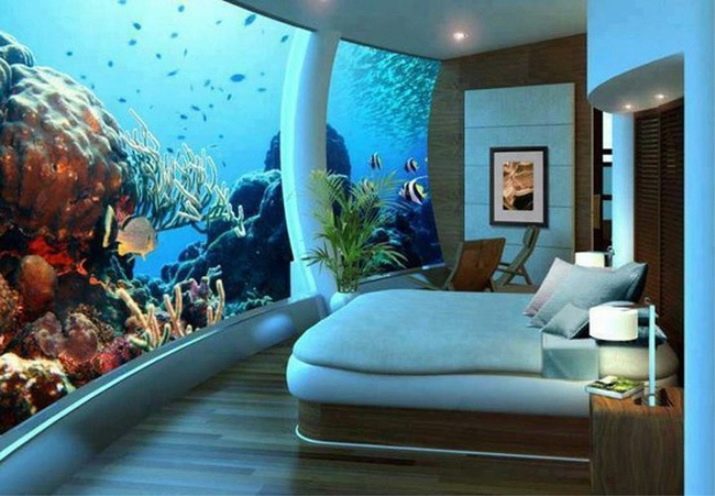
Finally, armed with certain knowledge, you can make the underwater world in your own, invented style. Someone is trying to get the "wreck of the Titanic", a copy of the famous ship sunken in the waters of the Atlantic, and they are the semantic center of the wall aquarium. Someone arranges a beautiful and unusual snag there, which is conceptual in itself. And, by the way, it was driftwood that replaced the previously popular bottles with gin inside and other fantasy stories.
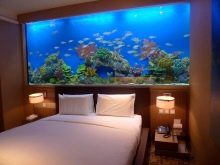
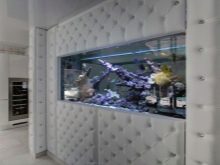
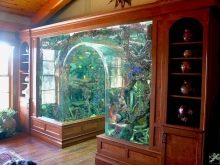
Increasingly, natural elements occupy a central place in home mini-ponds.
Sure, much in the design of an aquarium determines its size - if it is a 200 liter tank, it is subject to any style and variety in filling. Although the modern fashion for minimalism shows: elegance, unloaded elements look in the interior no less convincing.
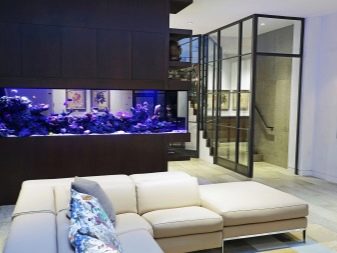
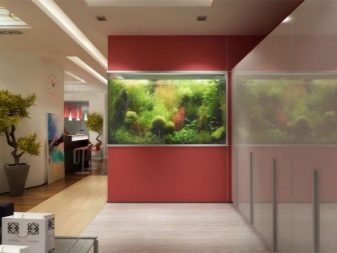
The aquarium in the wall can become the very “cherry on the cake” that the interior of your home lacked.
In the next video, see even more interesting information about aquariums for interior partitions.
